Utilizing Imaging Analysis to Determine the Internal Structure Characteristics of Asphalt Mixtures for Permeability and Moisture Damage Performance
Abstract
:1. Introduction
2. Materials and Methods
2.1. Experiment Method of Effect of Permeability on Indirect Tensile Strength
2.2. Indirect Tensile Strength Test
2.3. Permeability Test
- k = coefficient of permeability, cm/s;
- a = inside cross-sectional area of the buret, cm2;
- L = average thickness of the test specimen, cm;
- A = average cross-sectional area of the test specimen, cm2;
- t = elapsed time between h1 and h2, s;
- h1 = initial head across the test specimen, cm;
- h2 = final head across the test specimen, cm;
- tc = temperature correction for viscosity of water.
2.4. Image Processing and Analysis System (IPAS)
3. Results and Discussion
3.1. Effect of Different Filler Types on Water Permeability
3.2. Relationship between Water Permeability and Moisture Damage Resistance
3.3. Effect of Contact Length on Water Permeability
4. Conclusions
Author Contributions
Funding
Institutional Review Board Statement
Informed Consent Statement
Data Availability Statement
Acknowledgments
Conflicts of Interest
References
- Masad, E.; Al-Omari, A.; Lytton, R.; Masad, E.; Lytton, R. Simple Method for Predicting Laboratory and Field Permeability of Hot-Mix Asphalt in Transportation Research Record. J. Transp. Res. Board 2006, 1970, 55–63. [Google Scholar] [CrossRef]
- Kanitpong, K.; Bahia, H.; Russell, J.; Schmitt, R. Predicting Field Permeability from Testing Hot-Mix Asphalt Specimens Produced by Superpave Gyratory Compactor. Transp. Res. Rec. J. Transp. Res. Board 2006, 1929, 52–58. [Google Scholar] [CrossRef]
- Ban, H.; Kim, Y.; Rhee, S. Computational Microstructure Modeling to Estimate Progressive Moisture Damage Behavior of Asphaltic Paving Materials. Int. J. Numer. Anal. Methods Geomech. 2013, 37, 2005–2020. [Google Scholar] [CrossRef]
- Amelian, S.; Abtahi, S.M.; Hejazi, S.M. Moisture Susceptibility Evaluation of Asphalt Mixes Based on Image Analysis. Constr. Build. Mater. 2014, 63, 294–302. [Google Scholar] [CrossRef]
- Khan, R.; Grenfell, J.; Collop, A.; Airey, G.; Gregory, H. Moisture Damage in Asphalt Mixtures using the Modified SATS Test and Image Analysis. Constr. Build. Mater. 2013, 43, 165–173. [Google Scholar] [CrossRef]
- Sefidmazgi, N.R.; Tashman, L.; Bahia, H. Internal Structure Characterization of Asphalt Mixtures for Rutting Performance using Imaging Analysis. Road Mater. Pavement Des. 2012, 13 (Suppl. 1), 21–37. [Google Scholar] [CrossRef]
- Wielinski, J.C. Investigation of Permeable Asphalt Treated Base in Alabama. Master’s Thesis, Auburn University, Auburn, AL, USA, 2007. [Google Scholar]
- Abdullah, W.; Obaidat, M.; Nazem, M. Influence of Aggregate Type and Gradation on Voids of Asphalt Concrete Pavements. J. Mater. Civ. Eng. 1998, 10, 76–85. [Google Scholar] [CrossRef]
- Cooley, L.A., Jr.; Prowell, B.D.; Brown, E.R. Issues Pertaining to the Permeability Characteristics of Coarse-Graded Superpave Mixes; National Center for Asphalt Technology: Auburn, AL, USA, 2002; Volume 13, pp. 433–454. [Google Scholar]
- Tarefder, R.A.; White, L.; Zaman, M. Neural Network Model for Asphalt Concrete Permeability. J. Mater. Civ. Eng. 2005, 17, 19–27. [Google Scholar] [CrossRef]
- Mongkol, K.; Chaturabong, P.; Suwannaplai, A. Effect of Bagasse and Coconut Peat Fillers on Asphalt Mixture Workability. Coatings 2020, 10, 1262. [Google Scholar] [CrossRef]
- Coenen, A.; Kutay, M.E.; Sefidmazgi, N.R.; Bahia, H.U. Aggregate Structure Characterization of Asphalt Mixtures Using 2-Dimensional Image Analysis. Road Mater. Pavement Des. 2011, 13, 433–454. [Google Scholar] [CrossRef]
- ASTM D6926-10; Standard Practice for Preparation of Bituminous Specimens Using Marshall Apparatus. ASTM International: West Conshohocken, PA, USA, 2010.
- ASTM D6927-15; Standard Test Method for Marshall Stability and Flow of Asphalt Mixtures. ASTM International: West Conshohocken, PA, USA, 2015.
- Rachabut, K.; Chaturabong, P. Evaluation of Using Natural Fillers to Improve Moisture Damage Resistance and the Use of Pull-Off Tensile Test in Determining Moisture Damage Resistance in Asphalt Mixture. Appl. Sci. 2020, 10, 4318. [Google Scholar] [CrossRef]
- FM 5-565; Florida Method of Test for Measurement of Water Permeability of Compacted Asphalt Paving Mixtures Designation. Florida Department of Transportation: Tallahassee, FL, USA, 2015.
- Faheem, A.; Bahia, H. Modeling of Asphalt Mastic in Terms of Filler-Bitumen Interaction. J. Road Mater. Pavement Des. 2010, 11, 281–303. [Google Scholar] [CrossRef]

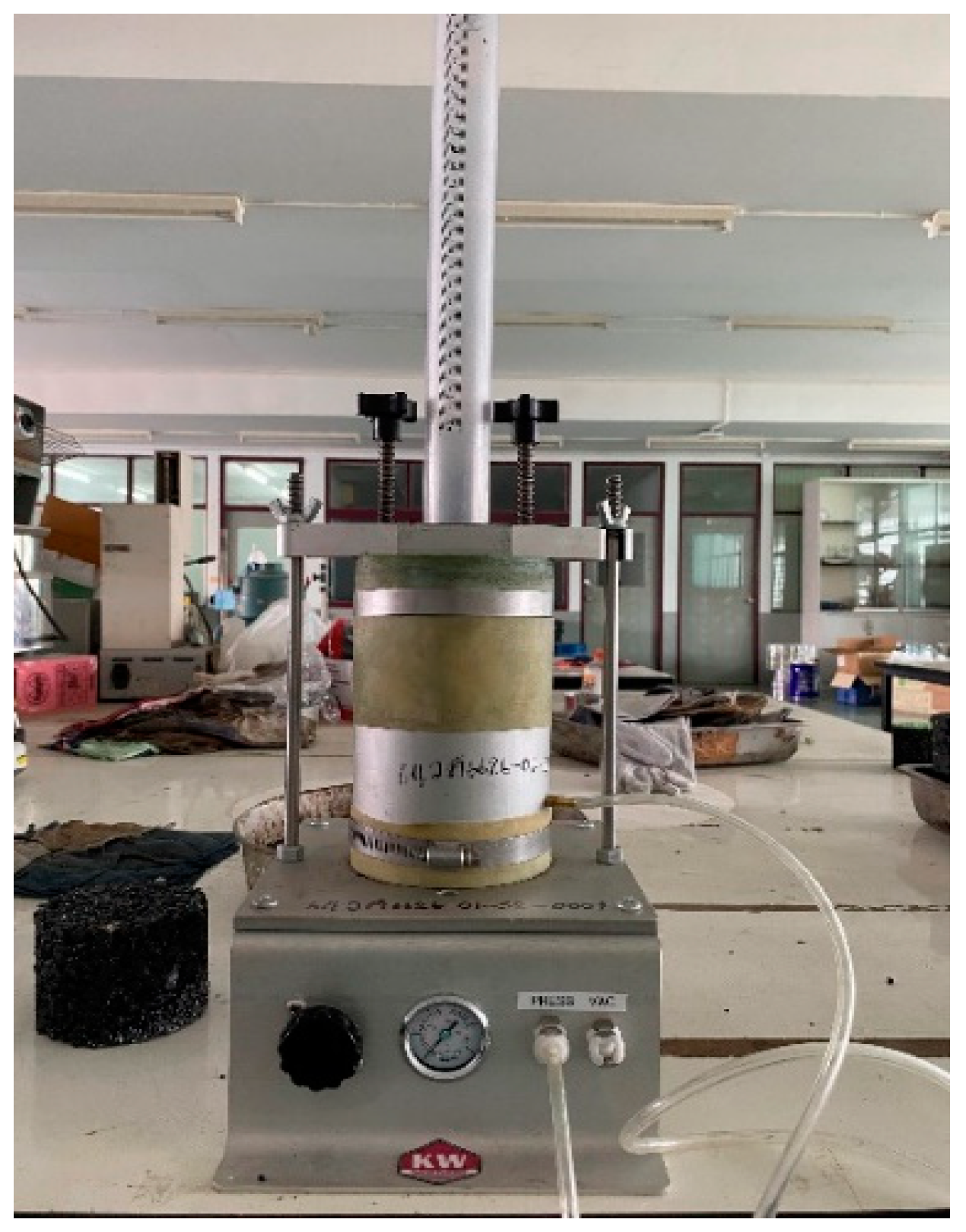
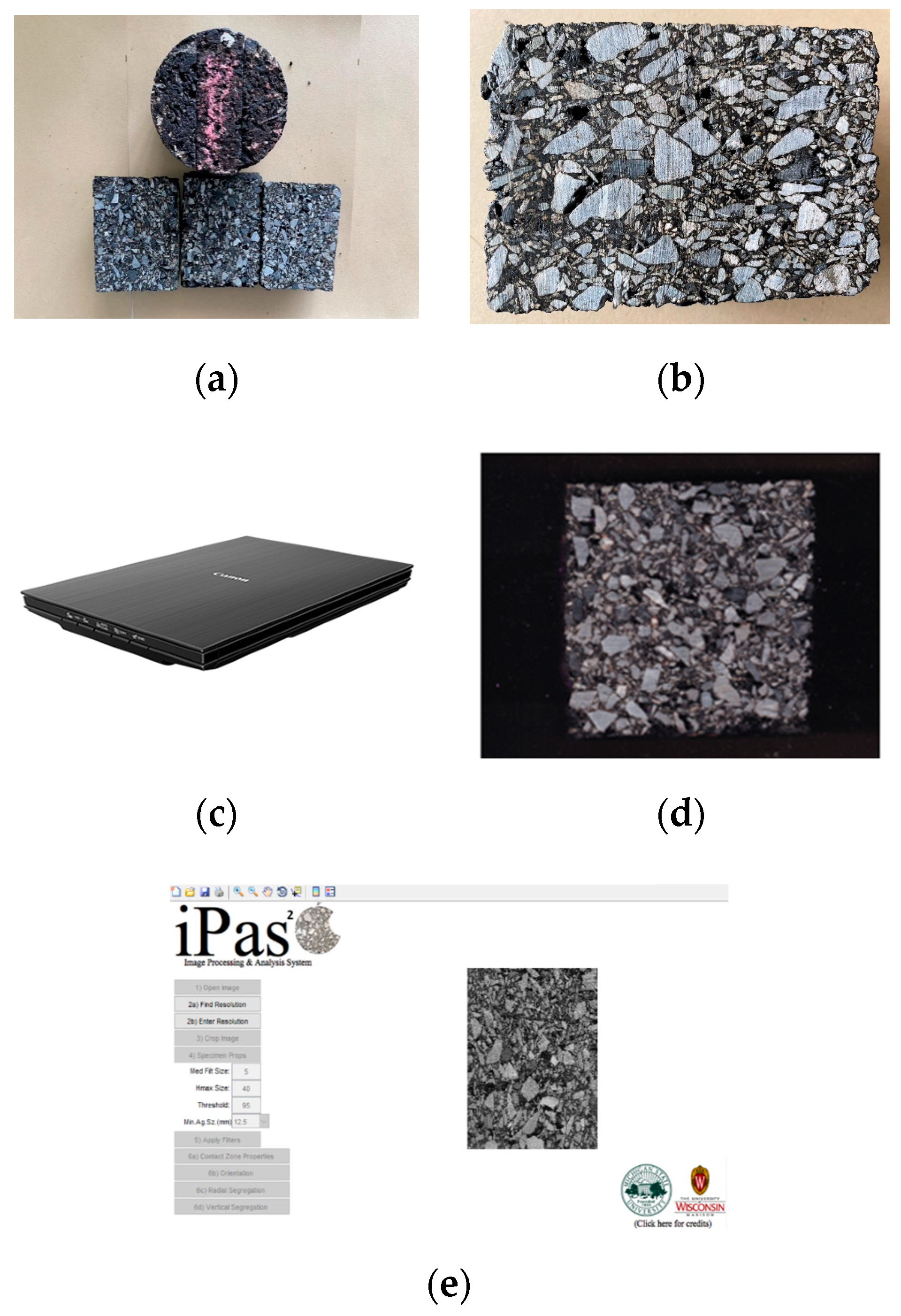
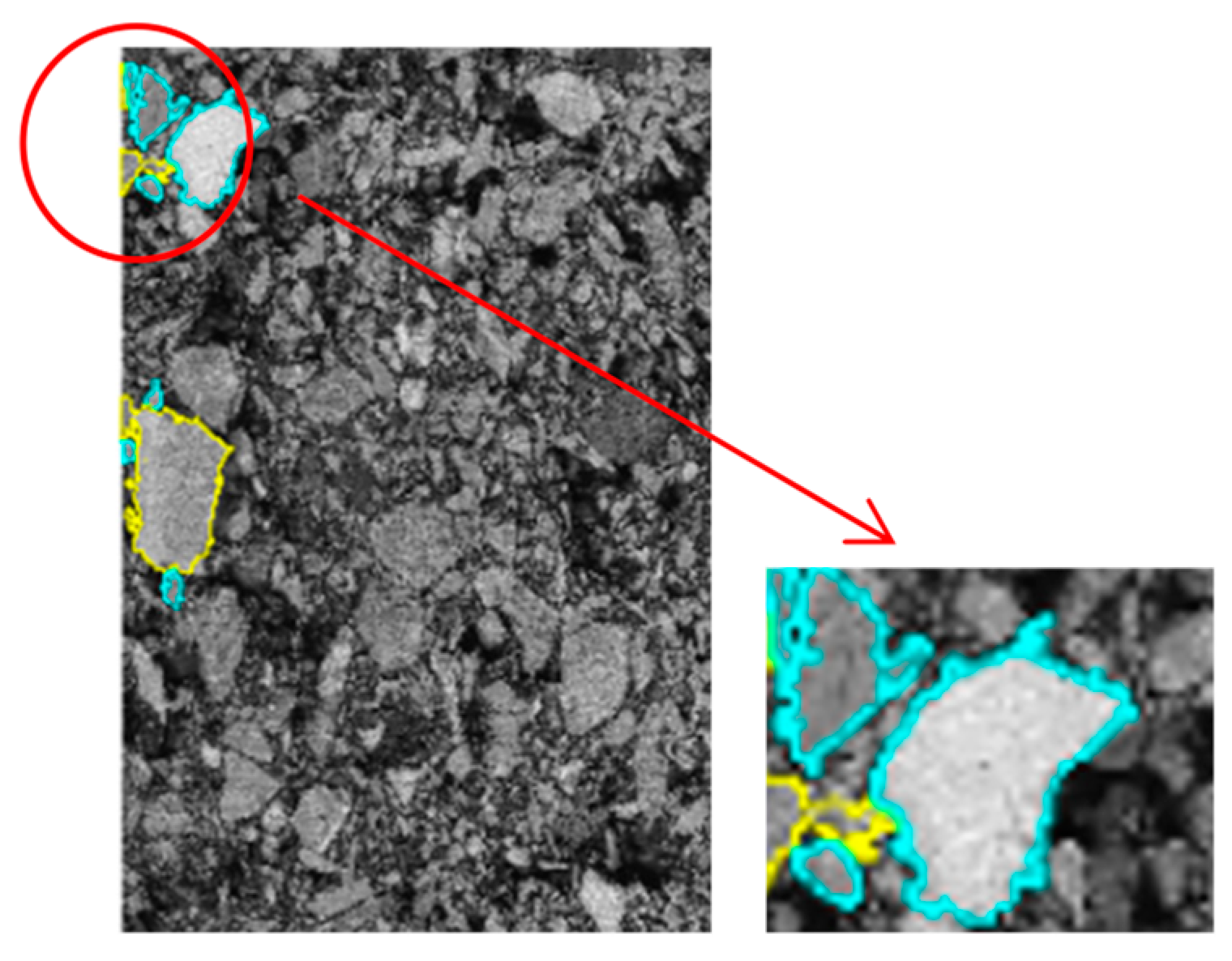
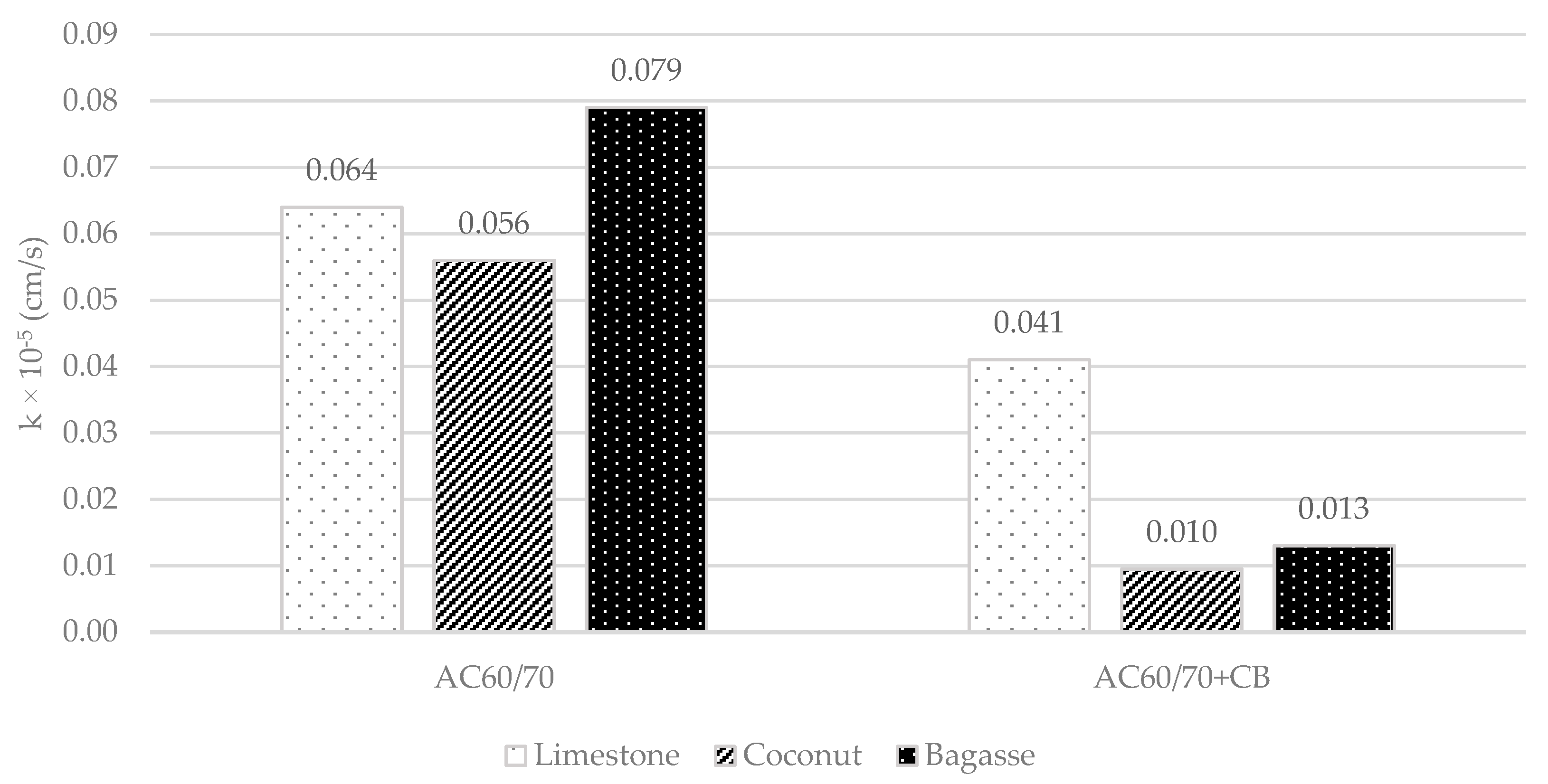
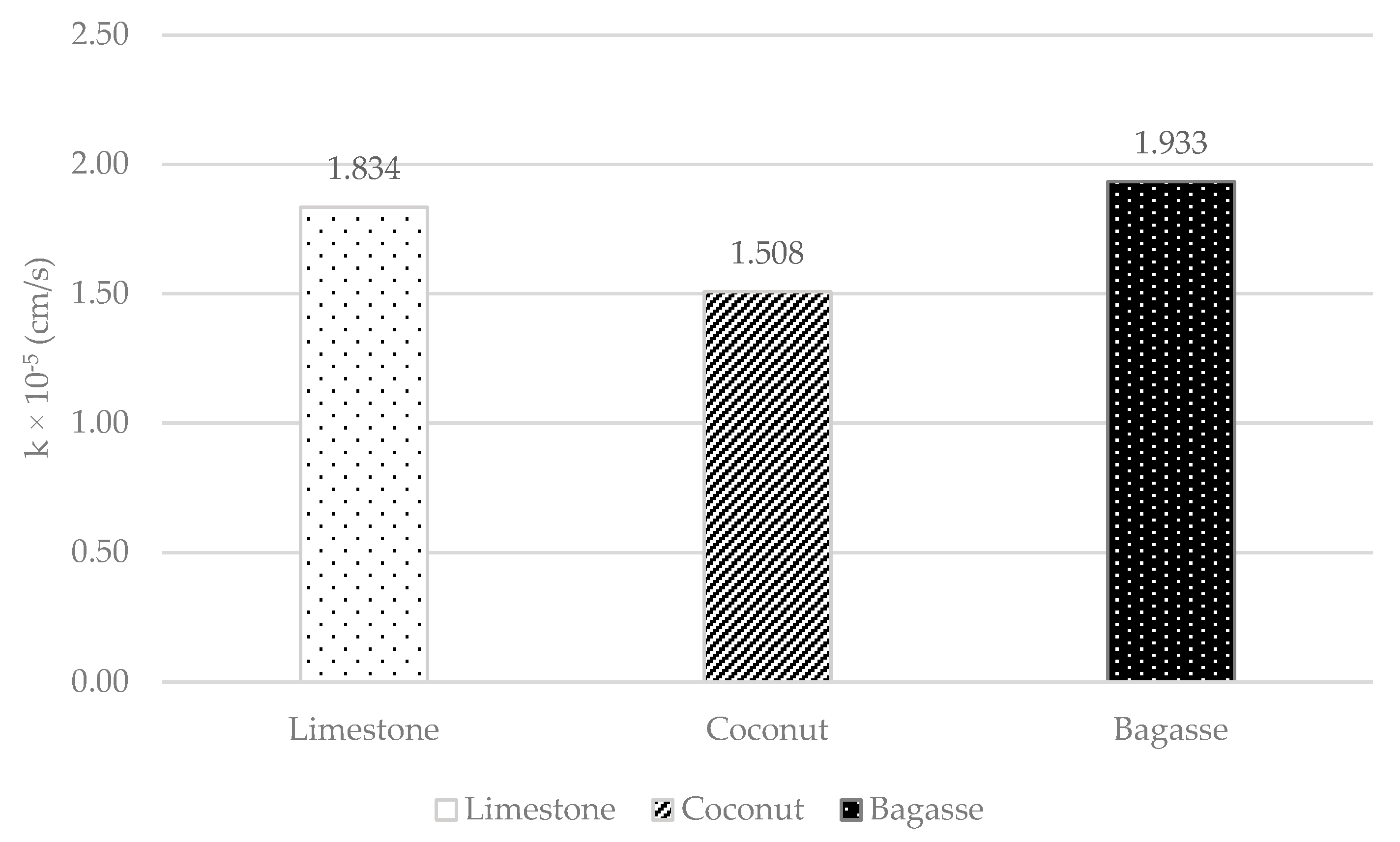
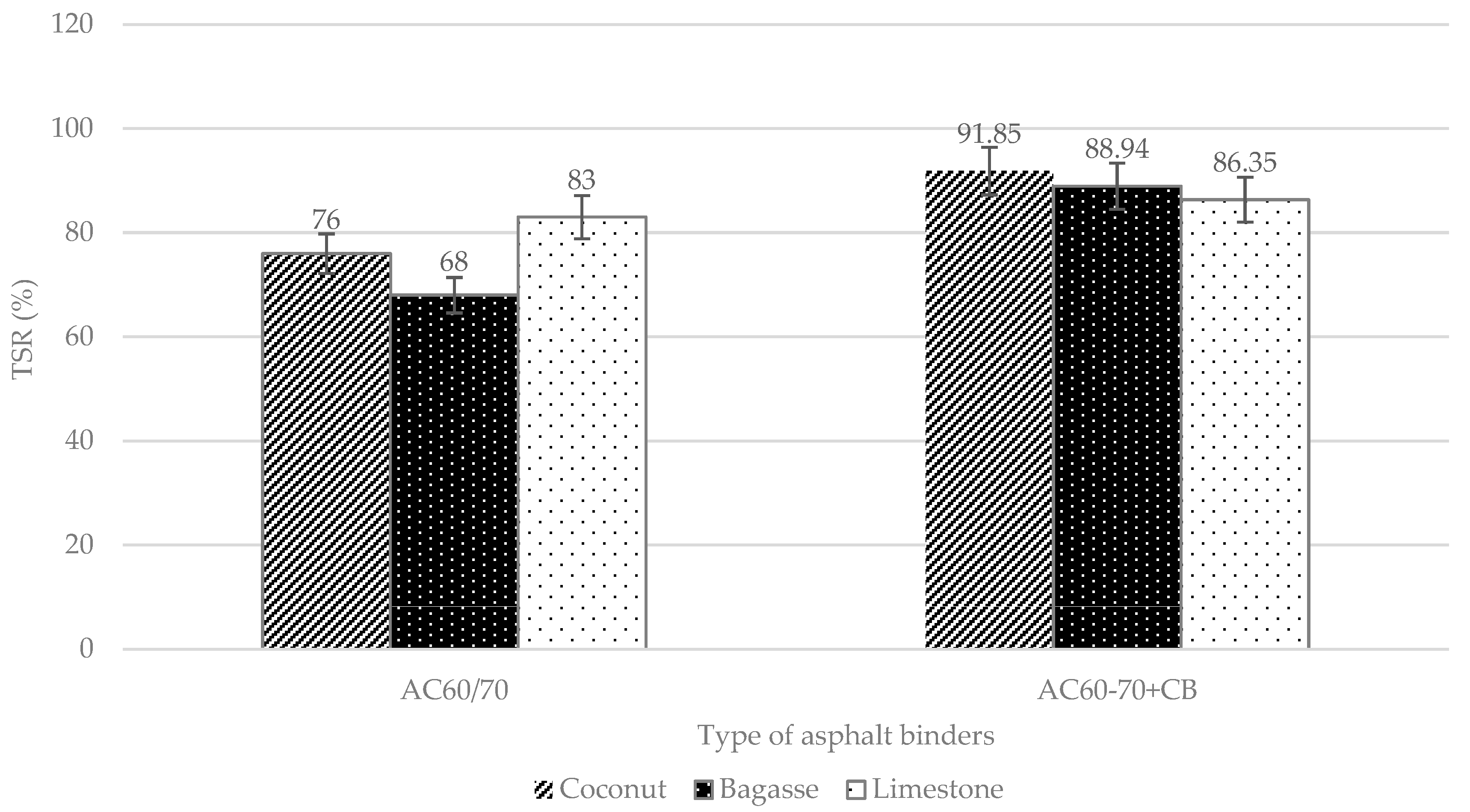
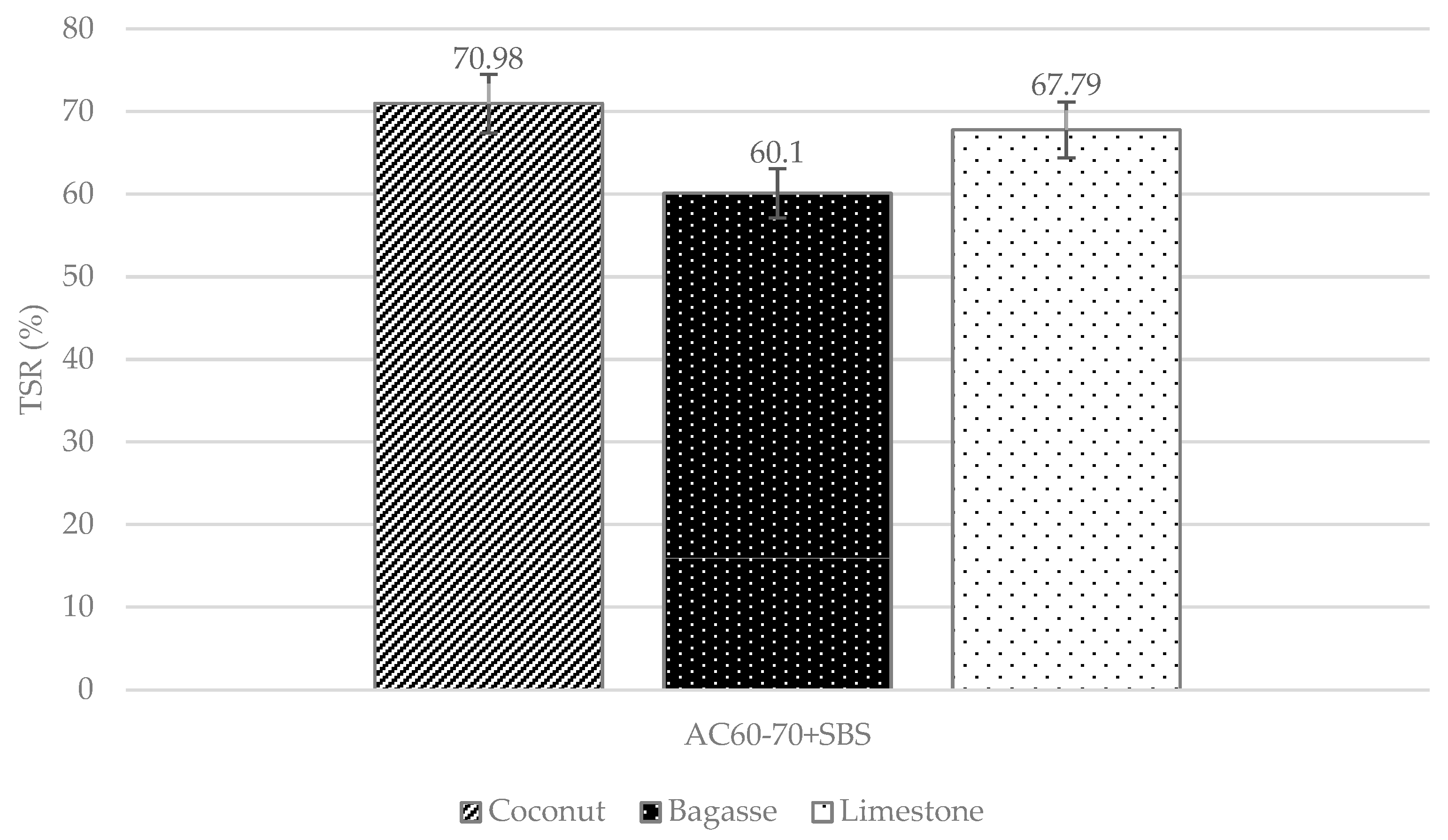
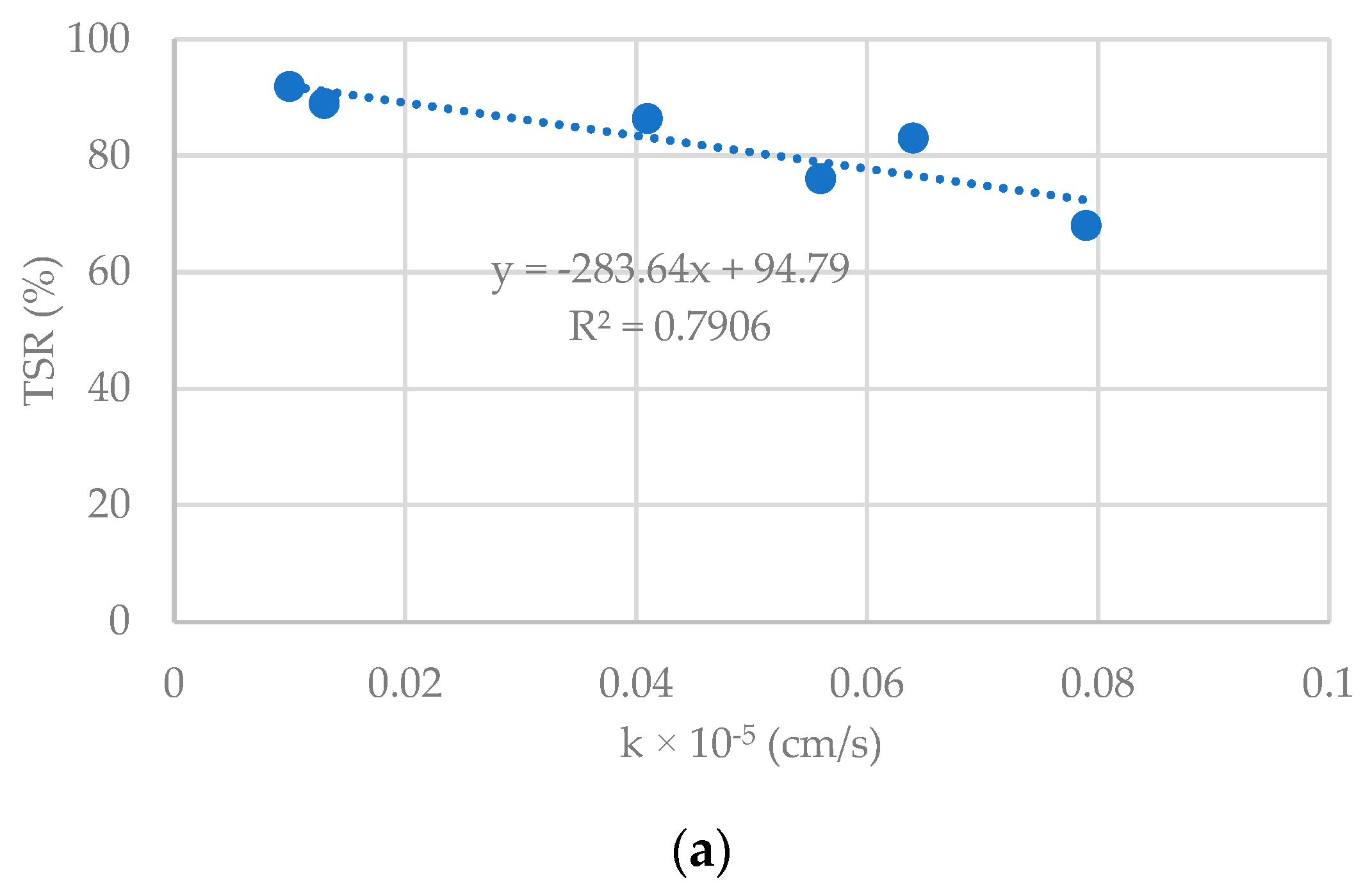

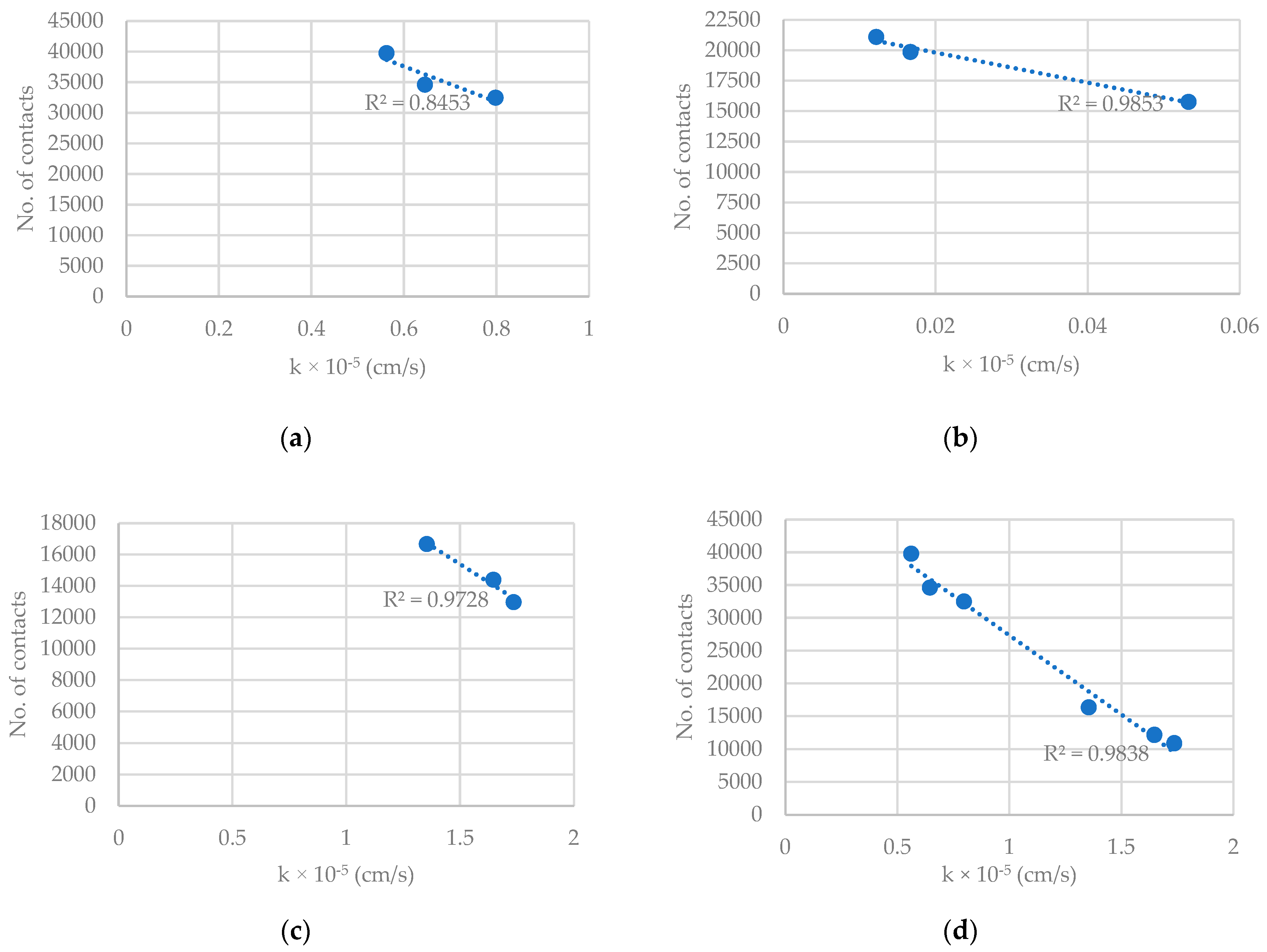


| Factor | Descriptions |
|---|---|
| Aggregate type | Limestone from Chonburi |
| Filler types | Bagasse, coconut peat, and limestone |
| Mixture types | Dense and porous |
| Binder types | AC 60-70 and AC60/70+Carbon Black for dense mixes |
| AC60/70+SBS for porous mixes |
| Type of Filler | Water Absorption (%) | Density (g/cm3) |
|---|---|---|
| Limestone | 1.59 | 2.62 |
| Bagasse | 69.3 | 0.38 |
| Coconut peat | 52.5 | 0.29 |
| Type of Asphalt Binder | Performance Grade |
|---|---|
| AC60/70 | PG58 |
| AC60/70+CB | PG70 |
| AC60/70+SBS | PG76 |
| Type of Filler | AC (%) | AV (%) | VMA |
|---|---|---|---|
| AC60/70 | |||
| Coconut peat | 5 | 4.4 | 18.4 |
| Bagasse | 5 | 4.0 | 20.0 |
| Limestone | 5 | 4.1 | 16.3 |
| AC 60/70+CB | |||
| Coconut peat | 7.3 | 4.2 | 16.0 |
| Bagasse | 7.5 | 4.0 | 15.4 |
| Limestone | 6 | 4.1 | 17.9 |
| AC 60/70+SBS | |||
| Coconut peat | 4.5 | 19.5 | 15.3 |
| Bagasse | 4.5 | 20.4 | 17.1 |
| Limestone | 4.5 | 19.8 | 17.5 |
| Filler | Dense Gradation | Porous Gradation | |
|---|---|---|---|
| Asphalt Binder | |||
| AC60/70 | AC60/70+CB | AC60/70+SBS | |
| k (cm/s) | |||
| Limestone | 0.064 × 10−5 | 0.041 × 10−5 | 1.834 × 10−5 |
| Coconut peat | 0.056 × 10−5 | 0.010 × 10−5 | 1.508 × 10−5 |
| Bagasse | 0.079 × 10−5 | 0.013 × 10−5 | 1.933 × 10−5 |
| Gradation | Binders | Fillers | No. of Aggregate Contacts | Total Aggregate Contact Length (mm) |
|---|---|---|---|---|
| Dense | AC60/70 | Coconut peat | 39,746.3 | 29,448.2 |
| Bagasse | 32,462.7 | 21,629.8 | ||
| Limestone | 34,585.5 | 23,805.2 | ||
| AC60/70+CB | Coconut peat | 21,084.9 | 11,320.6 | |
| Bagasse | 19,856.9 | 10,050.7 | ||
| Limestone | 15,751.7 | 7224.9 | ||
| Porous | AC60/70+SBS | Coconut peat | 16,654.0 | 16,315.9 |
| Bagasse | 14,375.9 | 10,853.8 | ||
| Limestone | 12,957 | 12,125.7 |
Disclaimer/Publisher’s Note: The statements, opinions and data contained in all publications are solely those of the individual author(s) and contributor(s) and not of MDPI and/or the editor(s). MDPI and/or the editor(s) disclaim responsibility for any injury to people or property resulting from any ideas, methods, instructions or products referred to in the content. |
© 2023 by the authors. Licensee MDPI, Basel, Switzerland. This article is an open access article distributed under the terms and conditions of the Creative Commons Attribution (CC BY) license (https://creativecommons.org/licenses/by/4.0/).
Share and Cite
Hemnithi, N.; Chaturabong, P. Utilizing Imaging Analysis to Determine the Internal Structure Characteristics of Asphalt Mixtures for Permeability and Moisture Damage Performance. Coatings 2023, 13, 584. https://doi.org/10.3390/coatings13030584
Hemnithi N, Chaturabong P. Utilizing Imaging Analysis to Determine the Internal Structure Characteristics of Asphalt Mixtures for Permeability and Moisture Damage Performance. Coatings. 2023; 13(3):584. https://doi.org/10.3390/coatings13030584
Chicago/Turabian StyleHemnithi, Nithinan, and Preeda Chaturabong. 2023. "Utilizing Imaging Analysis to Determine the Internal Structure Characteristics of Asphalt Mixtures for Permeability and Moisture Damage Performance" Coatings 13, no. 3: 584. https://doi.org/10.3390/coatings13030584
APA StyleHemnithi, N., & Chaturabong, P. (2023). Utilizing Imaging Analysis to Determine the Internal Structure Characteristics of Asphalt Mixtures for Permeability and Moisture Damage Performance. Coatings, 13(3), 584. https://doi.org/10.3390/coatings13030584





